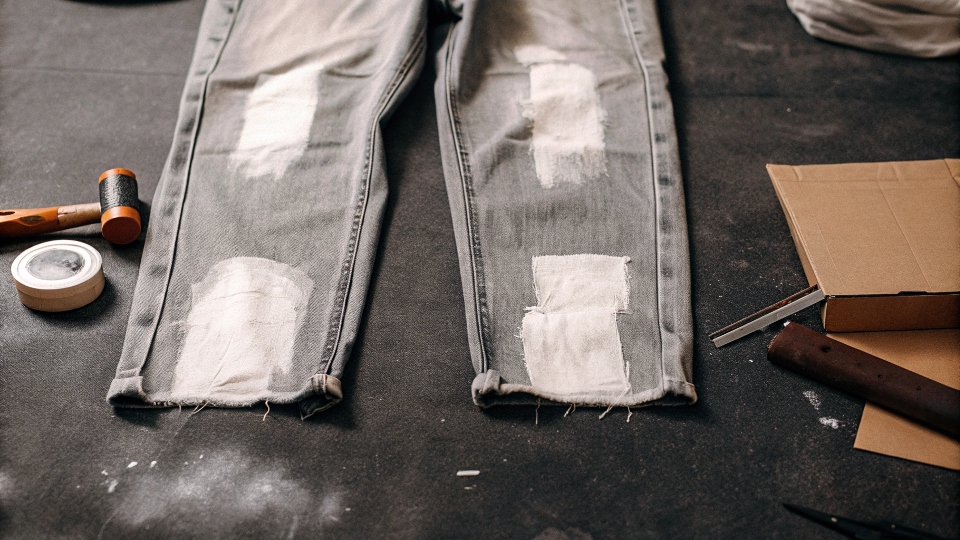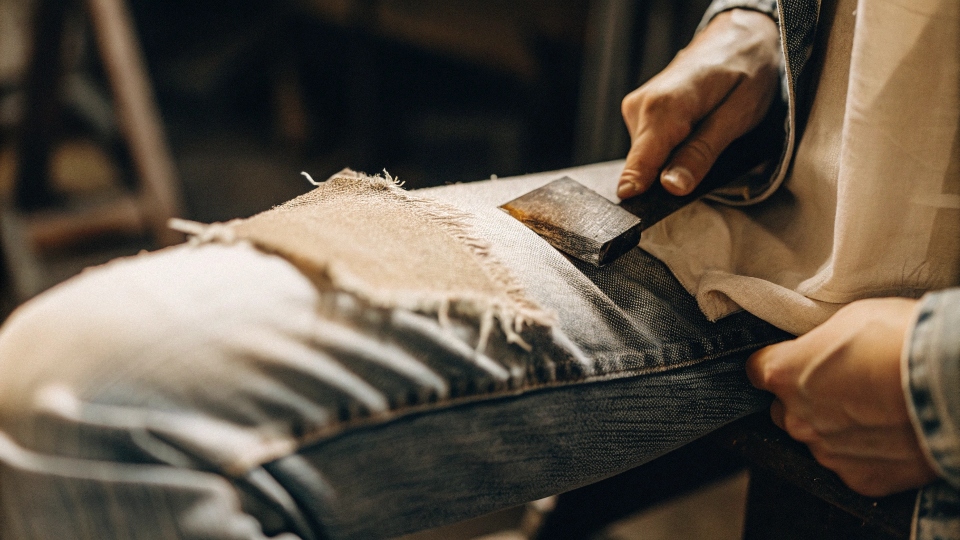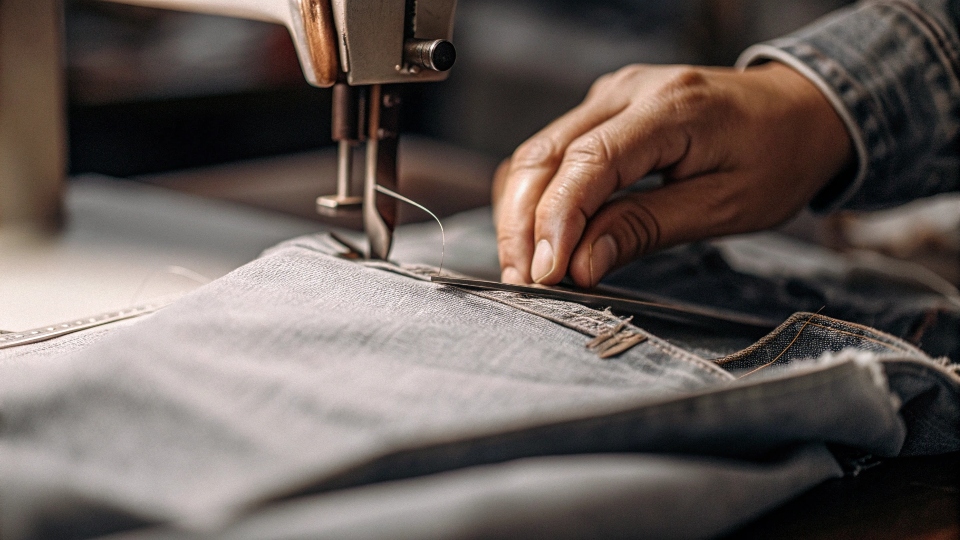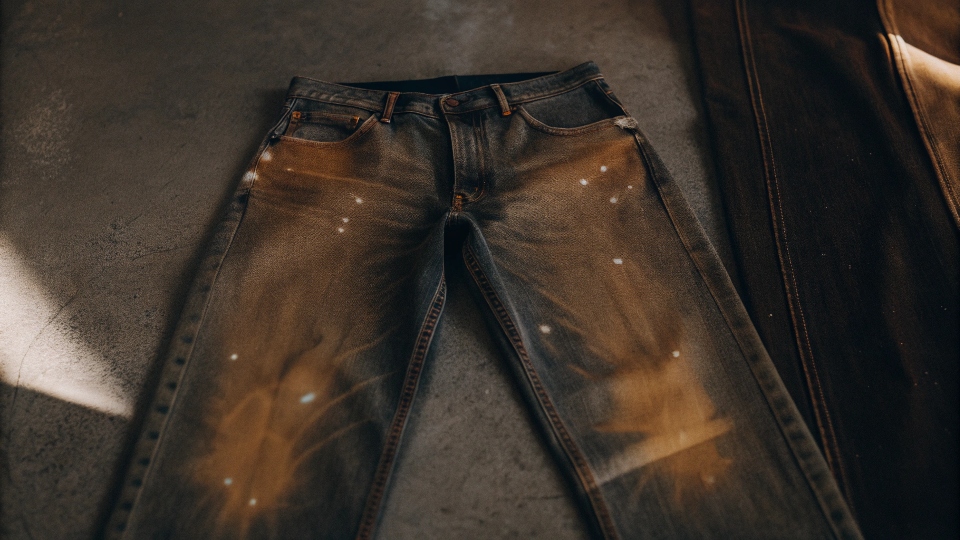You love the look of perfectly destroyed designer jeans1, but can't justify the high price tag. Trying it yourself seems risky—one wrong cut and you've ruined a perfectly good pair of pants.
First, mark your desired areas with chalk and place cardboard inside the leg. Make horizontal cuts with a razor, then use sandpaper to fray the edges. Finally, wash and dry the jeans to make the distressing look natural2.
In my two decades running a denim factory, I've seen every kind of distressing imaginable, from lasers and industrial sanders to workers using hand tools.
The goal is always the same: to make a new pair of jeans look like they have a story. The best-destroyed jeans look like they've been worn and loved for years.
The good news is that you can replicate this process at home with some simple tools and a little bit of patience. It’s less about destruction and more about artfully aging the fabric.
How to add destruction to jeans?
You want your jeans to look authentically worn-in, not just like you took a pair of scissors to them. You're worried your efforts will look amateur and obviously fake instead of effortlessly cool.
To add realistic destruction, you must first weaken and thin the fabric3 before you ever make a cut. Use tools like sandpaper or a cheese grater4 to abrade the areas you plan to rip, like the knees and thighs.
Think about how jeans wear out naturally. They don't just suddenly split open. First, the fabric gets thin and faded from years of rubbing and stress.
In the factory, we replicate this with large grinding machines. At home, you can achieve the same effect with abrasion5. Before you even think about cutting a hole, you need to break down the cotton fibers. Take a piece of medium-grit sandpaper6 and rub it vigorously on the areas you want to distress, such as the thighs, the knees, or around the pockets.
You'll literally see the indigo dye fade and the fabric start to thin out. This is the most important step for making the final rips and frays look like they happened over time, not in an afternoon.
Tools for Authentic Wear
| Tool | Effect | Best For |
|---|---|---|
| Sandpaper (Medium Grit) | Creates soft, natural-looking fading and thins the fabric. | Prepping areas for rips, fading thighs and seat. |
| Cheese Grater | Produces more textured scrapes and small, shred-like holes. | Adding texture to pocket edges and knees. |
| Pumice Stone | Softens edges and creates a gentle, fuzzy fray. | Finishing the edges of cuts and hems. |
| Craft Knife / Razor | Makes clean, precise cuts for creating rips. | The actual cutting process (Step 2). |
How to make your own rips in jeans?
You're ready to make the cuts, but you're nervous about creating a big, gaping hole that will just get bigger. You want that classic look with the white threads showing through the rip.
Place cardboard inside the jean leg. Use a sharp craft knife7 to make several horizontal cuts about a half-inch apart. Do not cut one big square. Afterwards, use tweezers to pull out the vertical blue threads.
This is where understanding how denim is made is a huge advantage. Denim is a twill weave, which means it has vertical threads (the "warp," which is dyed blue) and horizontal threads (the "weft," which is usually white).
The classic designer rip removes the blue warp threads while leaving the white weft threads intact. You can't achieve this by cutting a big hole. Instead, you need to perform delicate surgery on the fabric.
After you've thinned the area with sandpaper, make a series of parallel horizontal cuts. The space between these cuts will be your rip. Then, the magic happens: take a pair of tweezers and carefully start plucking out all the little vertical blue threads between your slits.
As you pull them out, you will reveal the horizontal white threads underneath. It's tedious work, but it is the only way to get that professional, net-like effect you see in high-end jeans.
How to make damages in jeans?
Rips and frays are a good start, but you want to add more unique character. You've seen jeans with paint splatters or bleach marks, but you're worried about going too far and making them look tacky.
For subtle damages, use a diluted bleach solution in a spray bottle for fading or flick small amounts of acrylic paint for a splatter effect. Less is always more, and remember to test on a hidden area first.
Beyond standard rips, you can add damages that tell a story. Think of your jeans as a canvas. One common technique in professional wash houses is creating sun-faded effects with chemicals.
You can mimic this at home with a very weak bleach solution, about one part bleach to three or four parts water. Put it in a spray bottle and lightly mist the jeans for a subtle fade, or use a sponge for more targeted spots.
Do this outside and wear gloves! Another great technique is paint splattering. Imagine you're a painter. Get a stiff brush, dip the very tip in some white or black acrylic paint, and flick it at the garment.
A few small, well-placed splatters look artistic; too many will just look like a messy accident. The key to both of these methods is restraint. You want the damages to look like they happened by chance over a long period.
What's the easiest way to fray jeans?
You want to cut off your jeans to make shorts or a cropped style with a perfectly frayed hem. The problem is that when you just cut them, the edge looks too clean and unnatural.
The easiest method is to cut the jeans to your desired length, manually pull out a few horizontal threads with tweezers to kickstart the process, and then run them through a hot wash and dry cycle.
Creating a frayed hem is probably the simplest way to customize your jeans, but there's a trick to it. Simply cutting the legs off with scissors will leave you with a boring, hard edge.
The secret weapon here is your washing machine. First, try on the jeans and mark where you want to cut, leaving about an extra inch of length to account for the fray.
Lay them flat and cut as straight as you can with sharp scissors. Now, here's the crucial step: you need to help the fraying begin. Use tweezers or a pin to pull out ten to fifteen of the horizontal white threads right along the raw edge.
This will loosen up the fabric's weave. Then, just toss them in the washing machine on a standard or heavy-duty cycle, followed by a trip through the dryer.
The heat and agitation will do all the hard work for you, blooming the raw edge into a soft, perfectly messy fray.
Conclusion
Making your own destroyed jeans is simple and rewarding. By carefully abrading, cutting, and washing the fabric, you can turn any plain pair into a custom piece that looks just like expensive designer denim.
-
Explore the concept of perfectly destroyed designer jeans and learn how to achieve that look without breaking the bank. ↩
-
Discover techniques to achieve a natural distressing look for your jeans, enhancing their style and character. ↩
-
Understand the significance of weakening fabric for realistic distressing and how it impacts the final look. ↩
-
Find out how to effectively use a cheese grater to add texture and character to your jeans. ↩
-
Learn about the process of abrasion in denim distressing and how it contributes to achieving a worn-in appearance. ↩
-
Learn about the role of medium-grit sandpaper in creating natural fading and distressing on jeans. ↩
-
Find recommendations for the best craft knives to use for precise cuts when distressing jeans. ↩











